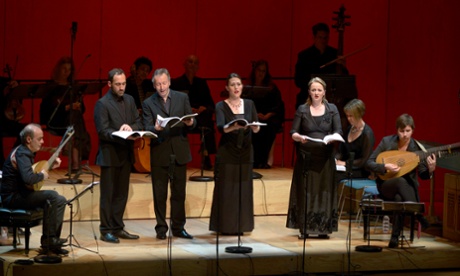
Since 2011, the French Baroque specialist group Les Arts Florissants has been working with its associate musical director, Paul Agnew, on a project to perform all of Monteverdi’s madrigals. Its two Milton Court concerts comprised the most substantial and arguably greatest of the composer’s collections: the Eighth Book, published in 1638, when he turned 71 (a ninth volume appeared posthumously).
In fact, the book covers a period of 30 years. One of the pieces – the Ballo Delle Ingrate, which is not a madrigal, but rather a short opera-ballet – was first performed in Mantua as far back as 1608. The result often feels like a summation of Monteverdi’s achievements in the genre, with a couple of other substantial items thrown in.
The collection’s dual themes are love and war – though these are not so far apart as one might assume, since the battles described in the warlike madrigals are those instigated by Cupid and usually lost by the lover, or situations where the lover is presented as a warrior.
Under Agnew’s virtually invisible direction, Les Arts Florissants delivered this consistently virtuosic music with a sure command of its individual lines, written for up to eight voices, and with a small string ensemble plus continuo group providing the well-honed accompaniments.
There were many highlights, with Antonio Abete moving his sepulchral bass around with focused precision in Altri Canti D’Amor, and giving the god Pluto a dark-toned authority in the Ballo Delle Ingrate, in which Lucile Richardot displayed her magnificent contralto. Agnew shone as the narrator in the other quasi-dramatic piece, the Combattimento di Tancredi e Clorinda, where Sean Clayton’s articulate tenor represented Tancredi and Hannah Morrison’s lithe soprano was Clorinda.
Above all, both programmes highlighted Monteverdi’s extraordinary harmonic language, his striking sense of colour, and the astonishing expressivity of his word-setting – all of which retain their potency after nearly 400 years.

